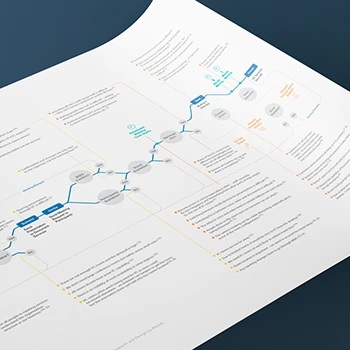How does Experience Thinking apply to fintech and insurance UX design?
Our Experience Thinking framework addresses four connected areas: how people experience your brand, content, products, and services. In fintech and insurance, this means ensuring your brand feels trustworthy, your content explains complex financial concepts clearly, your products solve real problems efficiently, and your services support customers through difficult moments like claims or financial stress. Each area strengthens the others to create end-to-end experiences that build lasting customer relationships.
Tip: Focus on mapping the complete customer lifecycle from awareness through long-term relationship management to identify where each Experience Thinking area can strengthen trust and reduce friction.
What makes fintech and insurance UX different from other industries?
Financial services require higher levels of trust, security perception, and regulatory compliance. Users often engage during stressful situations - filing claims, managing debt, or making major financial decisions. The stakes feel higher because people are dealing with their financial security and future. Additionally, complex products must be explained simply while maintaining accuracy for legal compliance.
Tip: Conduct stress-testing with users in simulated high-anxiety scenarios to identify where your interface might fail when people need it most.
How do you understand our specific audience and their financial behaviors?
We start with behavioral research to understand how your customers think about money, risk, and financial decisions. Through interviews, surveys, and observational studies, we uncover the emotional and practical factors that drive financial behavior. This includes understanding generational differences, financial literacy levels, and cultural attitudes toward money and insurance.
Tip: Include questions about past financial mistakes or regrets in your research - these reveal important decision-making patterns that surveys about ideal behavior miss.
What's your approach to balancing regulatory requirements with user experience?
We work closely with compliance to understand mandatory disclosures and legal requirements, then find ways to integrate them naturally into user flows. Rather than treating compliance as an afterthought, we design experiences where required information supports user understanding and decision-making. The goal is transparent communication that serves both legal protection and user comprehension.
Tip: Create a compliance-UX collaboration framework early in your project to identify potential conflicts before design work begins.
How do you help us define our UX strategy for financial products?
Using our Experience Thinking approach, we examine your brand promise, content strategy, product functionality, and service delivery as interconnected elements. We identify where your current experience creates trust or friction, then develop a roadmap for improvements that align with business goals and customer needs. The strategy considers both immediate usability wins and long-term relationship building.
Tip: Start with your highest-value customer journeys when prioritizing UX improvements - small changes in critical flows often deliver the biggest business impact.
What role does trust play in fintech and insurance UX design?
Trust is the foundation of every interaction in financial services. We design experiences that demonstrate competence through clear, accurate information; show benevolence through customer-first policies; and maintain integrity through transparent communication. Visual design, micro-interactions, and content tone all contribute to trust building. Even small design decisions can significantly impact perceived trustworthiness.
Tip: Audit your error messages and edge cases - these moments when things go wrong are often when trust is won or lost with customers.
How do you approach UX strategy for both customer acquisition and retention?
Acquisition focuses on reducing barriers to engagement and clearly communicating value propositions. Retention requires ongoing value delivery through self-service capabilities, proactive communication, and seamless problem resolution. We design experiences that recognize the customer's evolving relationship with your organization - from prospect to customer to advocate.
Tip: Map distinct experience requirements for each relationship stage to avoid designing one-size-fits-all solutions that serve no one well.
What research methods work best for understanding financial decision-making?
We use behavioral interviews to understand how people make financial decisions, diary studies to capture financial behaviors over time, and card sorting to understand mental models around financial concepts. Contextual inquiry helps us see how financial tasks fit into daily life, while usability testing reveals friction points in complex workflows.
Tip: Use retrospective interviews about recent financial decisions rather than hypothetical scenarios - actual behavior often differs significantly from intended behavior.
How do you conduct research on sensitive financial topics?
We use careful recruitment to find participants comfortable discussing financial matters, maintain strict confidentiality protocols, and structure conversations to gradually build comfort levels. Research sessions focus on behaviors and experiences rather than specific financial amounts or personal situations. We often use scenario-based discussions to explore decision-making without requiring personal disclosure.
Tip: Create research scenarios based on common financial situations rather than asking participants to share personal financial details.
What's your approach to testing complex financial workflows?
We break complex processes into manageable segments and test each part individually before testing end-to-end flows. Prototype testing starts with low-fidelity versions to validate core concepts before investing in detailed interfaces. We use think-aloud protocols to understand confusion points and measure both task completion and user confidence in their decisions.
Tip: Test with real data when possible - generic placeholder content often hides usability issues that emerge when users see their actual financial information.
How do you research across different financial literacy levels?
We recruit participants representing the full spectrum of financial knowledge and experience levels. Research methods adapt to meet participants where they are - using simplified language with beginners while exploring nuanced scenarios with financially sophisticated users. This helps us design experiences that work for everyone without talking down to any group.
Tip: Create separate test scenarios for different literacy levels rather than assuming one interface design will work equally well for all users.
What role does behavioral psychology play in your research approach?
Financial decisions are often emotional and irrational, so we examine the psychological factors that influence behavior. This includes understanding loss aversion, present bias, decision fatigue, and cognitive overload. We use techniques from behavioral economics to uncover why people make suboptimal financial choices and design experiences that support better decision-making.
Tip: Include behavioral triggers and biases in your research questions to understand the gap between what people say they'll do and what they actually do.
How do you validate that simplified explanations still meet legal accuracy requirements?
We collaborate with legal and compliance specialists throughout the research process. Content testing includes both user comprehension and legal review to ensure simplified language maintains required accuracy. We test multiple explanation approaches to find versions that are both legally compliant and genuinely helpful to users.
Tip: Create a content approval workflow that includes both legal review and user testing at each iteration rather than treating these as sequential steps.
What's your approach to researching financial stress and anxiety?
Financial stress research requires careful ethical considerations and trauma-informed approaches. We focus on understanding how stress impacts user behavior and decision-making without re-traumatizing participants. Research explores both the emotional experience and practical needs during difficult financial situations, helping us design supportive rather than stressful interactions.
Tip: Include mental health professionals in your research planning when studying financial stress to ensure ethical protocols and participant safety.
How do you design for financial transparency without overwhelming users?
Through our Experience Thinking content quadrant, we structure information hierarchically - leading with essential decisions and providing detailed explanations on demand. Progressive disclosure helps users get basic understanding quickly while making comprehensive information available when needed. Visual design uses typography, color, and spacing to create clear information hierarchies.
Tip: Test information disclosure patterns with actual customers to find the right balance between transparency and cognitive load.
What's your process for designing onboarding experiences for financial products?
Onboarding design starts with understanding the customer's emotional state and knowledge level when they arrive. We design progressive experiences that build confidence through small wins while gathering necessary information efficiently. The process balances legal requirements with user motivation, ensuring people complete onboarding without feeling overwhelmed or confused.
Tip: Track abandonment points in your current onboarding flow and prioritize fixing the step where you lose the most qualified prospects.
How do you approach mobile-first design for complex financial applications?
Mobile financial apps require careful prioritization since screen space is limited but financial tasks can be complex. We start with core task flows and design for thumb-friendly interactions while maintaining security standards. Progressive enhancement ensures desktop users get additional capabilities without compromising the mobile experience.
Tip: Design gesture-based navigation patterns that work with one hand since users often multitask while managing finances on mobile devices.
What's your approach to designing error states and failure scenarios?
Financial applications must handle errors gracefully since mistakes can have serious consequences. We design clear error messaging that explains what happened, why, and what to do next. Error prevention focuses on validation and confirmation patterns that catch mistakes before they cause problems. Recovery flows help users fix issues quickly without starting over.
Tip: Create error message libraries that address both technical failures and user mistakes with consistent tone and helpful guidance across all touchpoints.
How do you design accessible financial experiences for users with disabilities?
Accessibility in financial services goes beyond compliance to ensure everyone can manage their financial lives independently. We design for screen readers, motor impairments, and cognitive differences. This includes clear navigation structures, alternative input methods, and content that works well with assistive technologies. Financial inclusion means accessible design.
Tip: Include users with disabilities in your testing process from the beginning rather than retrofitting accessibility features.
What's your approach to designing dashboard experiences for financial data?
Financial dashboards must present complex data in ways that support decision-making rather than just displaying information. We design information hierarchies that highlight what matters most to each user type, use progressive disclosure for detailed analysis, and create visual patterns that help users quickly assess their financial status and identify areas needing attention.
Tip: Include customizable dashboard elements so users can prioritize the financial metrics most relevant to their specific goals and situations.
How do you design for security without creating friction?
Security design balances protection with usability by implementing appropriate security levels for different risk scenarios. We use behavioral biometrics, progressive authentication, and risk-based security that adapts to user behavior patterns. The goal is making secure actions feel natural rather than burdensome while maintaining strong protection against fraud.
Tip: Map security requirements to actual risk levels rather than implementing blanket high-security measures that frustrate users during low-risk activities.
How do you support development during financial product implementation?
We provide detailed design specifications that include interaction patterns, accessibility requirements, and security considerations specific to financial applications. Our support includes design reviews throughout development, helping resolve implementation questions, and ensuring the final product matches the intended user experience while meeting regulatory requirements.
Tip: Establish weekly design review checkpoints with development during implementation rather than waiting for major milestones to catch drift from intended designs.
What's your approach to measuring UX success in financial services?
Success metrics combine traditional usability measures with financial service-specific indicators like completion rates for complex applications, time to resolution for customer service issues, and trust indicators through user feedback. We establish baseline measurements and track improvements in both user satisfaction and business outcomes over time.
Tip: Include customer lifetime value and retention metrics in your UX measurement framework since financial service relationships are typically long-term.
How do you handle UX iteration within regulated financial environments?
Iteration in regulated environments requires careful change management processes that include compliance review at each iteration. We use A/B testing frameworks that meet regulatory requirements and document design decisions for audit purposes. Changes are implemented gradually with monitoring to ensure both improved user experience and continued compliance.
Tip: Create a change impact assessment template that evaluates both UX improvements and regulatory implications before implementing any design updates.
What's your approach to launching financial products with complex user bases?
Launch strategies consider the diverse needs within financial service customer bases. We recommend phased rollouts that start with user segments most likely to succeed, allowing time to gather feedback and make adjustments before broader release. Training and support materials are designed for different user skill levels and financial literacy.
Tip: Identify your most patient and engaged customer segment for initial rollouts - they'll provide valuable feedback while being forgiving of early issues.
How do you support ongoing UX optimization after launch?
Using our Experience Thinking service quadrant principles, we establish monitoring systems that track user behavior across all touchpoints - digital and human interactions. This includes regular user feedback collection, usability testing of updated features, and analysis of support ticket patterns to identify emerging friction points requiring design attention.
Tip: Set up automated alerts for unusual user behavior patterns that might indicate UX problems before they impact customer satisfaction scores.
What's your approach to training internal staff on UX principles for financial services?
Training programs are customized for different roles within financial organizations - customer service representatives need different UX knowledge than product managers or developers. We focus on practical applications relevant to each role and provide tools and frameworks that staff can use in their daily work to maintain customer-centered thinking.
Tip: Include customer service representatives in UX training since they often identify usability issues that don't surface in formal testing sessions.
How do you help organizations build internal UX capabilities for financial products?
We transfer knowledge through collaborative working relationships that build internal capabilities over time. This includes establishing UX processes, creating design systems specific to financial applications, and mentoring internal team members. The goal is sustainable UX practice that continues to evolve and improve after our direct involvement ends.
Tip: Start with establishing basic UX processes and measurement frameworks before investing in advanced design tools or hiring senior UX staff.
How do you design UX for regulatory compliance in fintech applications?
Compliance UX design integrates required disclosures and processes into natural user flows rather than treating them as obstacles. We work with legal specialists to understand specific regulatory requirements, then design experiences where compliance supports user understanding. This includes clear explanation of terms, transparent fee structures, and accessible privacy controls.
Tip: Map all regulatory requirements early in the design process to identify opportunities where compliance can actually enhance rather than hinder user experience.
What's your approach to designing for financial inclusion in fintech products?
Inclusive fintech design considers users who may be underbanked, have limited financial literacy, or face language barriers. We design simple interfaces that don't assume extensive financial knowledge, provide clear explanations of financial concepts, and ensure accessibility across different devices and connection speeds. The goal is expanding access to financial services rather than excluding users.
Tip: Include users from underserved communities in your research and testing to identify assumptions that might exclude potential customers.
How do you design payment and transfer experiences that feel secure and trustworthy?
Payment UX design focuses on clarity and confirmation at every step. Users need to understand exactly what will happen before committing to transactions. We design clear confirmation screens, provide immediate feedback for completed actions, and use visual and interaction design that conveys security and professionalism. Error prevention and recovery are crucial for maintaining trust.
Tip: Include transaction amount and recipient details in multiple confirmation steps to prevent costly user errors while building confidence in the process.
What's your approach to designing personal financial management interfaces?
Personal finance UX helps users understand their financial situation and make better decisions. This requires presenting complex financial data in digestible formats, providing actionable insights rather than just raw information, and supporting both detailed analysis and quick status checks. The interface adapts to different financial goals and sophistication levels.
Tip: Design financial insights that connect to specific actions users can take rather than just presenting data without context or next steps.
How do you design lending and credit application experiences?
Lending application design minimizes abandonment through clear progress indicators, explanation of requirements, and immediate feedback on application status. We design for transparency about approval criteria and timelines while gathering necessary information efficiently. The experience addresses anxiety around financial qualification and provides clear next steps regardless of application outcome.
Tip: Provide real-time feedback during application completion to help users correct errors before submission rather than rejecting completed applications.
What's your approach to designing cryptocurrency and digital asset interfaces?
Crypto UX design must balance sophisticated functionality with clear risk communication. We focus on education and progressive disclosure to help users understand complex concepts without overwhelming beginners. Security features are prominent without creating excessive friction, and we design clear confirmation patterns for irreversible transactions.
Tip: Include plain-language explanations of transaction fees and confirmation times before users commit to crypto transactions to prevent confusion and regret.
How do you design investment and wealth management experiences for different investor types?
Investment platform design accommodates different investor experience levels and goals. We create interfaces that provide simple options for beginners while offering detailed analysis tools for sophisticated investors. Information architecture helps users find relevant tools without being overwhelmed by functionality they don't need or understand.
Tip: Create progressive disclosure patterns that let novice investors grow into advanced features over time rather than hiding complexity behind separate 'expert' modes.
How do you design insurance shopping experiences that build confidence in coverage decisions?
Through our Experience Thinking product quadrant approach, we design comparison tools that help customers understand coverage differences without requiring insurance expertise. Clear explanations translate policy language into practical scenarios customers can relate to. Interactive tools let users explore how different coverage levels would apply to their specific situations, building confidence in their final choices.
Tip: Use scenario-based examples relevant to your customer's life stage rather than generic insurance terminology when explaining coverage options.
What's your approach to designing claims reporting and management experiences?
Claims experiences recognize that customers are often stressed, frustrated, or dealing with loss when they file claims. We design streamlined reporting processes with clear progress tracking and proactive communication about next steps. The interface provides emotional support through helpful guidance and reduces anxiety by clearly explaining what to expect throughout the claims process.
How do you design policy management interfaces that customers actually use?
Policy management design focuses on the actions customers actually need to take rather than displaying comprehensive policy information. We prioritize common tasks like updating personal information, making payments, and accessing important documents. Complex policy details are organized for easy scanning with search and filtering capabilities for specific needs.
What's your approach to designing insurance onboarding that reduces abandonment?
Insurance onboarding design breaks complex application processes into logical steps with clear progress indicators. We minimize upfront information requirements and use progressive data collection that builds understanding as customers move through the process. The experience explains why information is needed and how it affects pricing or coverage.
Tip: Save application progress automatically and allow customers to return later rather than forcing completion in a single session.
How do you design risk assessment and pricing transparency in insurance applications?
Transparent pricing design helps customers understand how their information affects insurance costs without overwhelming them with actuarial complexity. We use progressive disclosure to explain rating factors and provide interactive tools that show how changes in coverage or personal information impact pricing. The goal is informed decision-making without confusion.
Tip: Create interactive pricing calculators that let customers explore how different coverage levels and deductibles affect their premiums before they commit to a policy.
What's your approach to designing insurance customer service and support experiences?
Insurance customer service design recognizes that customers often contact support during stressful situations. We design self-service options that resolve common issues quickly while providing clear paths to human assistance when needed. Support experiences are integrated with policy information so customers don't need to repeat information across different service channels.
Tip: Create context-aware support experiences that recognize what policy or claim the customer is calling about and surface relevant information automatically.
How do you design life events workflows for insurance policy updates?
Life events like marriage, home purchase, or new children trigger insurance needs changes. We design workflows that proactively suggest relevant coverage updates and simplify the process of modifying existing policies. These experiences recognize the emotional significance of life events while efficiently handling the practical insurance implications.
Tip: Create automated triggers based on policy data patterns to identify customers who might benefit from coverage reviews during major life transitions.
How do you integrate AI tools into financial service experiences while maintaining trust?
AI integration in financial services requires transparency about when and how artificial intelligence is being used. We design experiences that clearly communicate AI involvement, provide human oversight options for important decisions, and ensure AI recommendations are explainable. The goal is leveraging AI capabilities while maintaining customer trust and regulatory compliance.
Tip: Always provide clear options for customers to speak with humans for complex or sensitive financial decisions, even when AI tools are available.
What's your approach to designing chatbot and virtual assistant experiences for financial questions?
Financial chatbots must handle sensitive information securely while providing genuinely helpful responses. We design conversation flows that recognize the limits of automated assistance and gracefully transfer complex or emotionally charged conversations to human specialists. The interface clearly identifies automated responses and provides easy escalation paths.
Tip: Design chatbot failures gracefully by creating clear handoff procedures to human agents rather than leaving customers stuck in unhelpful automated loops.
How do you design AI-powered financial advisory experiences?
AI advisory design balances algorithmic recommendations with human oversight and customer control. We create interfaces that explain the reasoning behind AI recommendations, allow customers to adjust parameters that influence advice, and provide clear disclaimers about the limitations of automated financial guidance. Trust is built through transparency and appropriate disclaimers.
Tip: Always include confidence levels or uncertainty ranges with AI financial recommendations to help users understand the reliability of automated advice.
What's your approach to using AI for fraud detection without creating customer friction?
Fraud detection UX design implements AI monitoring that works invisibly when possible and intervenes gracefully when necessary. We design verification processes that feel secure rather than punitive and provide clear explanations when additional verification is required. The system learns from customer behavior to minimize false positives over time.
Tip: Create adaptive fraud detection that considers customer behavior patterns and transaction history to reduce false positives for legitimate customers.
How do you design AI-enhanced customer service experiences in financial organizations?
Using our Experience Thinking service quadrant principles, we design AI-enhanced support that improves rather than replaces human interaction. AI helps route customers to appropriate specialists, provides agents with relevant customer context, and suggests solutions based on similar cases. The technology enhances human capability rather than attempting to replace personal service entirely.
Tip: Train AI systems on your organization's specific customer service standards and escalation procedures to ensure consistent experience quality.
What considerations are important when designing AI-powered financial analysis tools?
AI analysis tools must present complex financial insights in understandable formats while clearly indicating confidence levels and limitations. We design interfaces that help users understand what the AI can and cannot determine from available data. Visualizations make AI insights accessible while maintaining appropriate caution about automated financial analysis.
Tip: Include data quality indicators alongside AI insights so users understand when recommendations are based on incomplete or uncertain information.









